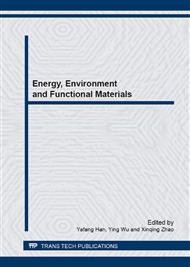p.198
p.205
p.210
p.215
p.221
p.227
p.232
p.236
p.242
Evaluation and Optimization of Ba0.2Sr0.8Co0.9Nb0.1O3-δ-Gd0.1Ce0.9O1.95 Composite Cathodes for IT-SOFCs
Abstract:
Ba0.2Sr0.8Co0.9Nb0.1O3-δ (BSCN0.2)-xGd0.1Ce0.9O1.95 (GDC) (x = 10, 20, 30 and 40 wt.%) composite cathodes were investigated for the potential application in the IT-SOFCs. The results of chemical compatibility measurement show that a small number of Gd and/or Ce ions may melt into the lattice of BSCN0.2 to form BSCN0.2-GDC solid solution. Thermal expansion coefficients effectively reduced by the incorporation of GDC. The electrochemical performance of BSCN0.2-xGDC composite cathodes increased with increasing x from 10 to 30 wt.%. When x = 30 wt.%, the area specific resistances were only 0.040 and 0.017 Ω cm2 at 750 and 800oC, respectively. This improved electrochemical performance is attributed to the good thermal expansion match between BSCN0.2-xGDC composite cathode and GDC electrolyte, and the increased oxygen vacancy concentration. With further increasing x, the electrochemical performance of the composite cathode decreased. This result may be due to the ambipolar resistance model of porous composite cathode and the poor electrical conductivity of BSCN-40GDC. The maximum power densities of a BSCN0.2-30GDC/La0.9Sr0.1Ga0.8Mg0.2O3-δ/NiO-Sm0.2Ce0.8O1.9 single-cell achieve 537 and 722 mW cm-2 at 750 oC and 800oC, respectively. These results indicate that the BSCN0.2-30GDC composite cathode is a promising candidate for IT-SOFC.
Info:
Periodical:
Pages:
221-226
Citation:
Online since:
April 2014
Authors:
Price:
Сopyright:
© 2014 Trans Tech Publications Ltd. All Rights Reserved
Share:
Citation:


